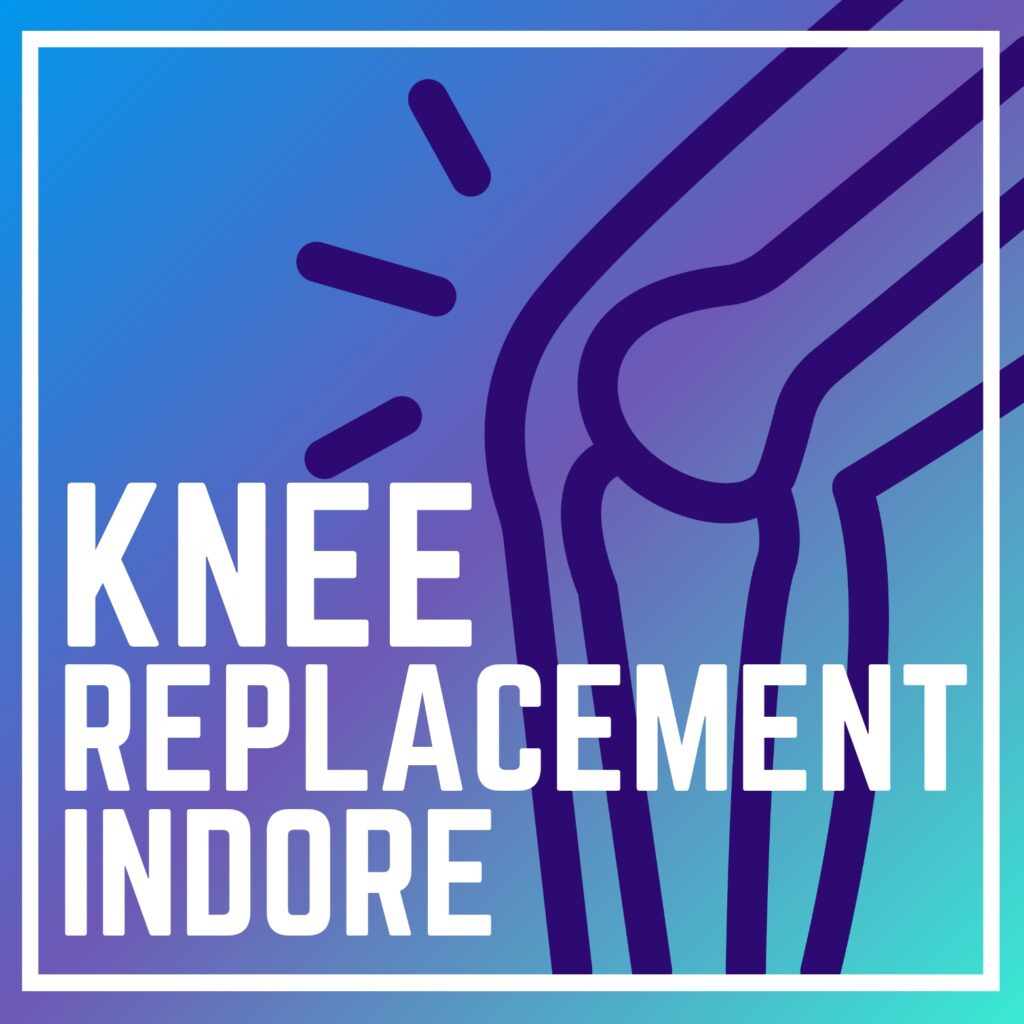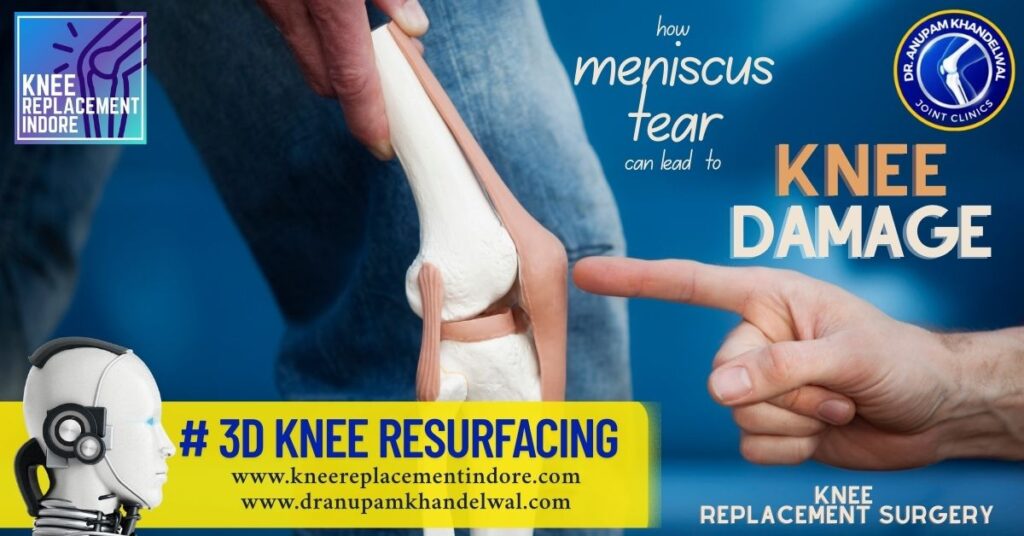Introduction
A meniscus tear is one of the most common knee injuries, especially among athletes, active adults, and even older individuals with degenerative changes. While many people ignore this injury or try to manage it with rest and painkillers, an untreated meniscus tear can gradually lead to severe knee damage, arthritis, and even the need for knee replacement surgery later in life.
In this blog, I, Dr. Anupam Khandelwal, a knee replacement and sports injury specialist in Indore, India, will explain how a meniscus tear affects your knee joint, the risks of delaying treatment, and the options available to protect your knee health. treatment, and the options available to protect your knee health.
What is the Meniscus?
The meniscus is a C-shaped cushion of cartilage in the knee that acts as a shock absorber between the thigh bone (femur) and shin bone (tibia). Each knee has two menisci – one on the inner side (medial meniscus) and one on the outer side (lateral meniscus).
Functions of the meniscus include:
Distributing body weight evenly across the knee joint
Protecting articular cartilage from wear and tear
Improving stability during walking, running, and bending
Absorbing impact and reducing stress on the bones
When the meniscus is torn, these vital functions are compromised, which puts the knee at risk of further degeneration.
Causes of Meniscus Tears
Sports injuries: Sudden twists or turns while playing football, basketball, or cricket
Accidents: Slips, falls, or road traffic injuries
Age-related wear and tear: Degenerative meniscus tears are common in people over 40
Obesity: Excess body weight puts more strain on the knee joint
Repetitive stress: Jobs or activities that involve frequent squatting or kneeling
Symptoms of a Meniscus Tear
Sudden pain after injury or twisting movement
Swelling in the knee joint
A popping or clicking sound while moving the knee
Stiffness and reduced range of motion
Feeling of the knee “locking” or “giving way”
Many patients ignore these symptoms, hoping they will go away. However, ignoring a torn meniscus can worsen the condition.
How a Meniscus Tear Leads to Knee Damage
- Increased Load on Cartilage
When the meniscus loses its cushioning function, body weight is transmitted directly onto the articular cartilage. Over time, this accelerates cartilage wear and tear, leading to osteoarthritis.
2. Progressive Joint Instability
The meniscus helps stabilize the knee. A torn meniscus increases the risk of the knee slipping or locking, causing ligament injuries and further damage.
3. Inflammation and Swelling
Persistent inflammation damages the lining of the joint (synovium), resulting in chronic pain and stiffness.
4. Early Arthritis
Studies show that untreated meniscus tears can lead to knee osteoarthritis within 10–20 years (Englund et al., 2009, Arthritis & Rheumatism).
5. Need for Knee Replacement Surgery
In advanced cases, repeated damage caused by meniscus loss can lead to severe arthritis, making knee resurfacing or knee replacement surgery the only option for restoring mobility.
Diagnosis
Clinical examination by an orthopaedic surgeon
MRI scan to confirm the type, size, and location of tear
X-ray to check for associated arthritis
Treatment Options
Conservative Management (for small tears):
Rest, Ice, Compression, Elevation (RICE)
Physiotherapy and strengthening exercises
Pain-relieving medications
Arthroscopic Surgery:
Meniscus repair – suturing the torn meniscus
Partial meniscectomy – removing the damaged portion while preserving healthy tissue
Advanced Techniques in Indore:
Robotic-assisted arthroscopy for precision repair
Biological therapies like platelet-rich plasma (PRP) to promote healing
Knee Replacement (only if arthritis develops and damage is irreversible).
Prevention of Knee Damage After Meniscus Tear
Do not ignore persistent knee pain or swelling
Get early consultation and MRI if symptoms persist
Maintain healthy weight to reduce knee stress
Strengthen thigh and calf muscles with supervised exercises
Avoid squatting, twisting, or sudden jerky movements during recovery
Conclusion
A meniscus tear is not just a minor sports injury – if left untreated, it can silently damage your knee and progress to arthritis. Early diagnosis, timely treatment, and lifestyle changes can prevent long-term complications.
As an orthopaedic surgeon specializing in knee care, I strongly advise patients in Indore and across India not to delay consultation if they have persistent knee pain or swelling. Modern arthroscopic and robotic techniques allow us to treat meniscus tears effectively and preserve knee function for years to come.
Hindi Summary
घुटने की मेनिस्कस चोट को नज़रअंदाज़ करना खतरनाक हो सकता है। समय पर इलाज न होने पर यह धीरे-धीरे आर्थराइटिस और घुटने की स्थायी क्षति का कारण बन सकती है। डॉ. अनुपम खंडेलवाल, इंदौर में, आधुनिक तकनीकों से मेनिस्कस टियर का सटीक इलाज करते हैं और घुटने की सुरक्षा सुनिश्चित करते हैं।
African Summary
Kuchanika kwa meniscus ya goti bila matibabu sahihi kunaweza kusababisha kuharibika kwa goti na ugonjwa wa arthritis. Kutafuta ushauri wa daktari mapema huzuia uharibifu wa kudumu. Dr. Anupam Khandelwal huko Indore, India, hutumia mbinu za kisasa za upasuaji ili kurekebisha matatizo ya meniscus na kuhifadhi afya ya magoti.
FAQs (Patients also ask)
Small meniscus tears sometimes heal with rest, physiotherapy, and medicines. However, larger or complex tears usually do not heal without surgical repair. Consulting a knee specialist helps decide the best treatment
If ignored, a meniscus tear can lead to persistent pain, knee locking, swelling, and gradual cartilage damage. Over time, this increases the risk of early arthritis and may even require knee replacement in the future.
No. Not all meniscus tears require surgery. Treatment depends on the size, type, and location of the tear, as well as the patient’s age and activity level. Some can be managed conservatively, while others benefit from arthroscopic repair.
Early treatment, weight control, strengthening exercises, avoiding high-impact activities, and following medical advice are the best ways to protect your knee from long-term damage.
Yes. With advanced arthroscopic and robotic-assisted techniques available in Indore, meniscus surgery is safe, minimally invasive, and has a quick recovery time when performed by an experienced orthopaedic surgeon like Dr. Anupam Khandelwal.


